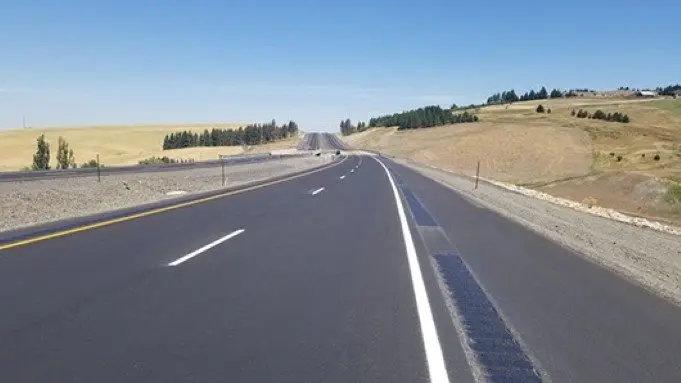Legislation concerning drones ran into immediate concerns at its first hearing over questions on whether it would allow people to hunt wolves from the air
Ranchers losing cattle and sheep to coyotes and foxes want to be able to hire out-of-state aerial hunters statewide to protect their livestock, and the state would like to be sure drones can’t be used to spot or hunt game in Montana, according to two bills that saw their first committee hearings at the Montana Legislature on Thursday.
“While other predators get a lot of the headlines, predation by coyotes is still the No. 1 depredation issue for landowners across the state,” said Department of Livestock executive director Mike Honeycutt in one of the hearings.
But the bill allowing out-of-state aerial hunters is being amended to stay in line with federal reporting requirements, Honeycutt and the bill’s sponsor said at the onset of its first committee hearing this week.
Hearing sparks questions on wolves and infrared drones
The bill on drones also ran into immediate concerns at its first hearing Thursday over questions on whether it would allow people to hunt wolves from the air and when drones could be used.
Senate Bill 84 was requested by the Department of Fish, Parks and Wildlife and is sponsored by Sen. Bob Brown, R-Trout Creek.
It would make changes to further clarify in statute that hunters cannot use aircraft to spot or harass animals. The bill would add Unmanned Aerial Vehicles, or UAVs – commonly known as “drones” – to the definition of “aircraft.”
The Fish and Wildlife Commission previously addressed the issue in its hunting regulations, but the bill, if passed, would “make the law much clearer” in statute, said Fish, Parks and Wildlife Chief of Law Enforcement Ron Howell at Thursday’s hearing in the Senate Fish, Wildlife and Parks Committee.
“The department frequently receives questions and complaints about unmanned aerial vehicles being used for hunting purposes and harassing wildlife,” Howell said.
Under the measure as introduced, drones could not be used to harass game animals or game birds. It would also make it illegal for a person to fly any drone or other aircraft to locate – then hunt on the same day in the same area – game animals, which include elk, mountain lions and bears; furbearers like bobcats, wolverines and martens; or game birds.
The bill would also prohibit killing any of those classifications of animals from any aircraft, including drones.
“We have the responsibility to ensure that hunting in Montana remains an accessible pursuit involving woodsmanship, fair chase and skill — not one that’s dominated by technology that tips the scale too far in the favor of hunters who can afford the latest gadgets or upgrades,” said Katjana Stutzer, who testified in favor of the bill on behalf of the Montana chapter of Backcountry Hunters & Anglers.
Though Brown said it was a “pretty simple bill” at the start Thursday’s hearing, opponents raised questions about why wolves were not included in the language of the bill while other commonly hunted animals were.
“The bill has omitted wolves in both the list of species it applies to and to the penalty section,” said Nick Gevock, who testified in opposition on behalf of the Endangered Species Coalition. “We believe this law should apply as well to wolves.”
Another opponent representing Montana Audubon agreed. Gevock said he believes that “with simple amendments,” the bill has a chance to tighten statute “and maintain Montana’s strong tradition of setting a higher standard in wildlife management.”
Montana Fish, Parks and Wildlife Director Hank Worsech told lawmakers, who asked about specifically including wolves in the bill through an amendment, that he would take a look, perhaps listing wolves as furbearers. The committee chairman said he was not sure if that would be allowed under the bill’s title.
“Obviously, we missed it on this part,” Worsech said.
Democrats on the committee said they believed there was a potential loophole in the measure as introduced about when drones could be used to spot game.
The Fish and Wildlife Commission defines a hunting day as a half-hour before sunrise to a half-hour after sunset, Howell said.
Senate Minority Leader Pat Flowers, D-Belgrade, said he felt that definition and the bill’s language would allow people to fly a drone with an infrared camera just before the hunting day starts to spot animals they would then go hunt a short time later.
Howell said he would look into that and get back with Flowers, who said he was not questioning the ethics of hunters in general but was concerned about “bad actors.”
In February, the U.S. Fish and Wildlife Service said hunting wolves and other animals from the air is prohibited “in most circumstances” after FWP argued the state’s law did not ban aerial hunting of wolves, as the Montana State News Bureau reported.
On Thursday, Republican Gov. Greg Gianforte directed the FWP to develop a new Wolf Management Plan, which a department spokesperson said it hoped to complete by the end of the year.
Brown said he would resist amendments to the bill, which he said had nothing to do with wolves. But he acknowledged there was “room there for some possible adjustments” regarding the infrared drones.
A change, but little opposition, to out-of-state hunters bill
The other aerial hunting bill heard Thursday, House Bill 104, would make changes to allow nonresidents with permits to shoot coyotes and red foxes, which are designated as livestock predators, from helicopters or fixed-wing aircraft in every county in Montana instead of only in counties that border other states.
A similar bill sponsored by Sen. Butch Gillespie, R-Ethridge, in 2019 passed the Senate 43-6 but died in the House Fish, Wildlife and Parks Committee.
“It would give us another avenue to help keep the population control at a nice level, especially right before calving and lambing,” Gillespie said in an interview.
At the request of a livestock producer, pilots can apply for a $50 permit to aerially hunt coyotes and red foxes for predator removal purposes through the Department of Livestock.
According to Administrative Rules of Montana, aerial hunters currently must be residents of Montana, but the Board of Livestock can issue permits to nonresidents “when adequate service cannot be provided by Montana permittees.”
The Livestock Loss Board reimburses ranchers who likely or certainly lost livestock to wolves, grizzly bears, or mountain lions — but not coyotes or foxes. In 2022, the board paid out $209,814 to 89 stock owners.
The bill, now sponsored by Rep. Brandon Ler, R-Savage, originally contained language that would have removed a requirement in current statute that landowners notify the state government they would be utilizing aerial hunting on the property and provide a description of the land that would be hunted.
But Ler said Thursday in a House Agriculture Committee hearing that he had requested an amendment to remove that language after the Department of Livestock, which requested the bill, found it would have run afoul of federal reporting requirements.
“The feds just require the reporting of these aerial hunters on a yearly basis,” Ler said after the hearing.
Honeycutt, the Department of Livestock executive director, said Thursday only 18 of Montana’s 56 counties could currently utilize aerial hunting. He said out of 30 pilots registered to do so at the moment, only four were not Montana residents.
The hunters remove about 1,500 coyotes annually, Honeycutt said — about one-quarter of the total killed in Montana each year in conjunction with work the state does with the U.S. Department of Agriculture’s Wildlife Services. He said aerial hunting is a “significant tool” in helping deal with coyote depredation and that he hopes the bill passes so the state can attract more pilots and help livestock growers not in border counties.
“We have received contact from folks from other states wishing to do this, but it is a deterrent that they can only operate in those counties that are on the state boundary,” Honeycutt said.
At a fall meeting, he said the border-county requirement leaves ranchers in northern Montana in particular in a lurch because they share a border with Canada.
“The Hi-Line is just completely out of luck if somebody from Texas, per se, wanted to go up and do a deal with ranchers to aerial hunt coyotes in those areas,” Honeycutt said.
The measure received testimony from proponents representing the Montana Farm Bureau Federation and the Montana Stockgrowers Association. It received no opposition.
Gillespie said he was not surprised the drone law was being tightened up.
“Say I’m your neighbor and go check everything out, see a big buck in a far coulee, then sell that info or go to a good buddy and just kind of clue ‘em in,” he said.
Differing opinions among other hunters
Gillespie’s 2019 bill had also been requested by the Department of Livestock.
He said in an interview though he understands that some people do not support the means of predator control, it is necessary to keep the populations of coyotes and foxes at bay to protect smaller livestock.
“One thing about coyotes: It doesn’t seem to be how much you hunt them, there’s going to be a multitude of them in a month or two,” Gillespie said. “It’s amazing they can come out, whether it’s the (U.S. Department of Agriculture) or state planes, they get quite a few. And a couple, three days later, you hear coyotes yelling and howling.”
He said his bill faced opposition from the Montana Wool Growers Association over opening aerial hunting up to nonresidents before it died in the FWP committee.
The Wool Growers Association has not testified yet on the bill this year, and it did not return a phone call asking its position on this year’s bill.
At a hearing in 2019, Dave McEwen, with the association, said his issue with inviting in out-of-state hunters for aerial management was they would only come in when fur prices were high unless a landowner pays them for the services.
He said the USDA’s Wildlife Services was the only agency anyone should be paying to do “very selective work” on people’s properties.
Mac Minard, the executive director of the Montana Outfitters and Guides Association, said in an interview before the measure’s first hearing that he believes the residency requirements can be “an artificial barrier that is serving a questionable purpose” if the overall mission is to reduce predator numbers.
“It would make tremendous sense. Heck, some of them are ranching in multiple states,” he said.
Minard said the Montana Outfitters and Guides Association had an “unequivocal” opposition to using drones for hunting purposes.
“The use of drones for spotting game and reporting back, we believe, is outside the realm of fair chase,” he said.
Joe Perry, with the Montana Sportsman’s Alliance, said in a phone call prior to the hearing that he would be closely watching similar legislation and lawmakers this session to be sure Montana hunters aren’t being hurt at the expense of nonresidents.
Perry said the alliance has not officially taken a position on either bill, but he doesn’t agree with nonresidents being allowed to hunt from the sky.
“There’s been a pile of breaks given to nonresidents and few breaks given to us,” he said.




